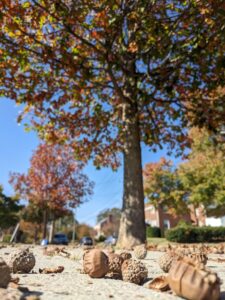
 As winter approaches, the age-old debate over whether nature offers clues to predict the upcoming snowfall season resurfaces. While meteorologists rely on sophisticated tools and models to forecast winter weather, there is a surprising and fascinating connection between the abundance of acorns and the possibility of heavy snowfall. In recent research and articles, experts have explored the intriguing correlation between acorn mast years and intense winter snowstorms. Let’s delve into this unusual phenomenon and understand how acorns may serve as a natural forecast for a snowy winter.
As winter approaches, the age-old debate over whether nature offers clues to predict the upcoming snowfall season resurfaces. While meteorologists rely on sophisticated tools and models to forecast winter weather, there is a surprising and fascinating connection between the abundance of acorns and the possibility of heavy snowfall. In recent research and articles, experts have explored the intriguing correlation between acorn mast years and intense winter snowstorms. Let’s delve into this unusual phenomenon and understand how acorns may serve as a natural forecast for a snowy winter.
A mast year, as defined by the Washington Post, is a year in which trees like oaks produce a particularly abundant crop of nuts, such as acorns. This natural event tends to occur irregularly, making it challenging to predict. Nevertheless, research has shown that the presence of a mast year can be indicative of specific weather patterns during the upcoming winter season.
Interestingly, researchers and ecologists have observed a fascinating pattern over the years, linking mast years to the severity of upcoming winter snowfall. Although the exact reasons for this connection are not fully understood, several theories have emerged to clarify this interesting occurrence.
 One possible explanation is that the trees might be sensing harsher winter conditions in advance, prompting them to produce a surplus of seeds as a survival strategy. This surplus serves as a form of insurance, ensuring that at least some of the seeds will survive and germinate to sustain the tree population, even under unfavorable winter circumstances.
One possible explanation is that the trees might be sensing harsher winter conditions in advance, prompting them to produce a surplus of seeds as a survival strategy. This surplus serves as a form of insurance, ensuring that at least some of the seeds will survive and germinate to sustain the tree population, even under unfavorable winter circumstances.
Another theory, alternatively, proposes that the increased production of acorns could be a response to favorable weather conditions in the preceding year. A hot, dry, sunny growing season followed by a warm late winter and an early spring correlates with the seed production of individual trees. It can also indirectly lead to synchronization among many trees.
The connection between mast years and winter snowfall severity remains a subject of ongoing research and fascination among experts. While the precise mechanisms behind this relationship continue to be a topic of debate, the theories surrounding the phenomenon provide valuable insights into the complex interactions between natural ecosystems and winter weather patterns. Further research in this area is crucial for a comprehensive understanding of how natural phenomena can offer clues about upcoming seasonal changes and weather patterns.

